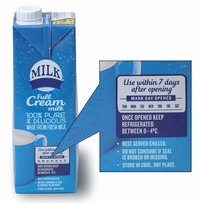
Food Safety Focus (101st Issue, December 2014) – Food Safety Platform
To Eat or Not to Eat After Expiry Date?
Reported by Ms. Janny MA, Scientific Officer,
Risk Assessment Section,
Centre for Food Safety
Have you ever sniffed at a food that has just passed the date marked on food label and wondered if it is still safe to eat? Your nose will not tell you much but the "best before" or "use by" dates provided along may give you some clues.
"Best Before" and "Use By" Dates? What is the Difference?
In Hong Kong, like some other places such as Australia, New Zealand and the European Union, both "best before" and "use by" dates are the compulsory form of date marking, which provide consumers with a guide to the shelf life of prepackaged food.
"Best before" dates relate to food quality for example taste, texture, aroma and appearance. If the food is stored properly, it can reasonably be expected to retain its specific properties up to and including the specified date. In general, foods that do not contain and/or support the growth of food poisoning bacteria (e.g. canned foods and frozen foods), as well as foods that require cooking or other processing to reduce or eliminate food poisoning bacteria before consumption (e.g. fresh meat) may carry a "best before" date. A "best before" date may also be applied to foods, such as plain bread, that obviously spoiled (e.g. mouldy, rancid or stale) before posing a food safety risk to the consumer.
On the contrary, "use by" dates refer to food safety. From microbiological point of view, the food is highly perishable and is therefore likely after a short period to constitute an immediate danger to human health. For instance, some refrigerated ready-to-eat foods that may contain and support the growth of food poisoning bacteria to unsafe levels before noticeably spoiled should carry a "use by" date. Currently, there is no definitive list of which foods should carry a particular type of date mark. The trade, particularly the manufacturers who are the ones more familiar with the nature of and ingredients used in the final product, has the responsibility to set the appropriate date mark i.e. either a "best before" or "use by" date, together with the storage instructions (e.g. "keep refrigerated") to achieve the stated shelf life.
To Eat or Not to Eat?
Nevertheless, once the packaging of the food is opened, the above suggestions as well as the date mark may become irrelevant. For instance, ultra-high-temperature (UHT) treated milk can be kept safely in its sealed container without refrigeration for months; yet, after opening, bacteria can enter and begin to grow in the milk. We should therefore follow the manufacturer's instruction, for example "after opening, keep refrigerated at or below 4oC and finish the product within seven days", regarding the length of time and storage condition after opening.

Manufacturer's instruction as shown on the packaging of UHT milk after opening
Advice to the Public
- Take note of the "use by" or "best before" date of the food items before purchase or consumption.
- Food beyond its "use by" date should be avoided while be wary of the quality of food beyond the "best before" date.
- Do not purchase or consume food if the packaging is damaged as it may have been contaminated or deteriorated even if it is still within the date marked on the food label.
Advice to the Trade
- Do not sell food after its "use by" date.
- Ensure food sold after its "best before" date is still fit for human consumption.
- Consult with technical experts before giving a "use by" or "best before" date mark for a food.



